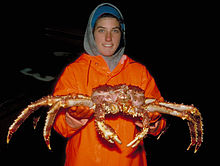King crab: Difference between revisions
Stemonitis (talk | contribs) m formatting |
→Species: typo's |
||
| Line 38: | Line 38: | ||
==Species== |
==Species== |
||
[[Image:Redkingcrab.jpg|thumb|left|220px|A woman holding a red king crab (''Paralithodes camtschaticus'').]] |
[[Image:Redkingcrab.jpg|thumb|left|220px|A woman holding a red king crab (''Paralithodes camtschaticus'').]] |
||
The '''red king crab''', '''''Paralithodes camtschaticus''''', is the most coveted comercially sold king crab and is the most expensive per [[Pound (mass)|pound]]. It is most commonly caught in [[Bristol Bay]] and [[Norton Sound]], [[Alaska]], and is particularly difficult to catch, but is nonetheless the most |
The '''red king crab''', '''''Paralithodes camtschaticus''''', is the most coveted comercially sold king crab and is the most expensive per [[Pound (mass)|pound]]. It is most commonly caught in [[Bristol Bay]] and [[Norton Sound]], [[Alaska]], and is particularly difficult to catch, but is nonetheless the most preferred crab for consumption and has been said to be the best tasting in the world. Red king crab gets its name from the colour it turns when it is cooked rather than that of its actual colour while still alive, which tends to be more [[burgundy (color)|burgundy]]. |
||
The '''blue king crab''', '''''Paralithodes platypus''''', is caught off [[St. Matthew Island]] and the [[Pribilof Islands]], Alaska, and is the largest of all the king crabs. The blue king crab is |
The '''blue king crab''', '''''Paralithodes platypus''''', is caught off [[St. Matthew Island]] and the [[Pribilof Islands]], Alaska, and is the largest of all the king crabs. The blue king crab is often sold as the coveted red king crab because when it is cooked it resembles and tastes similar to red king crab. |
||
The '''golden king crab''', '''''Lithodes aequispinus''''', is caught in the [[Aleutian Islands|Aleutian Chain]] off the coast of Alaska. The golden king crab is significantly smaller than the red and blue crab types, but tastes similar to the red and blue king crabs. They are, however, considerably cheaper due to |
The '''golden king crab''', '''''Lithodes aequispinus''''', is caught in the [[Aleutian Islands|Aleutian Chain]] off the coast of Alaska. The golden king crab is significantly smaller than the red and blue crab types, but tastes similar to the red and blue king crabs. They are, however, considerably cheaper due to their appearance and size. |
||
The '''scarlet king crab''', '''''Lithodes couesi''''', is not often fished for since it is not sold |
The '''scarlet king crab''', '''''Lithodes couesi''''', is not often fished for since it is not sold commercially. This is due to the small size and lack of population to allow a commercial harvest. |
||
{{unreferenced}} |
{{unreferenced}} |
||
Revision as of 13:45, 21 June 2006
| King crabs | |
|---|---|

| |
| Paralithodes rathbuni | |
| Scientific classification | |
| Kingdom: | |
| Phylum: | |
| Class: | |
| Order: | |
| Suborder: | |
| Infraorder: | |
| Superfamily: | |
| Family: | Lithodidae Samouelle, 1819
|
| Genera | |
| |
King crabs, also called stone crabs, are a family of crab-like decapod crustaceans chiefly found in cold seas. Their large size means that many species are widely caught and sold as food.
King crabs are generally believed to be derived from hermit crab ancestors, which may explain the asymmetry still found in the adult forms. Although some doubt still exists about this theory, king crabs are the most widely-quoted example of carcinisation among the Decapoda.
Species

The red king crab, Paralithodes camtschaticus, is the most coveted comercially sold king crab and is the most expensive per pound. It is most commonly caught in Bristol Bay and Norton Sound, Alaska, and is particularly difficult to catch, but is nonetheless the most preferred crab for consumption and has been said to be the best tasting in the world. Red king crab gets its name from the colour it turns when it is cooked rather than that of its actual colour while still alive, which tends to be more burgundy.
The blue king crab, Paralithodes platypus, is caught off St. Matthew Island and the Pribilof Islands, Alaska, and is the largest of all the king crabs. The blue king crab is often sold as the coveted red king crab because when it is cooked it resembles and tastes similar to red king crab.
The golden king crab, Lithodes aequispinus, is caught in the Aleutian Chain off the coast of Alaska. The golden king crab is significantly smaller than the red and blue crab types, but tastes similar to the red and blue king crabs. They are, however, considerably cheaper due to their appearance and size.
The scarlet king crab, Lithodes couesi, is not often fished for since it is not sold commercially. This is due to the small size and lack of population to allow a commercial harvest.
References
See also
The term king crab is also sometimes used of the horseshoe crab Limulus.
